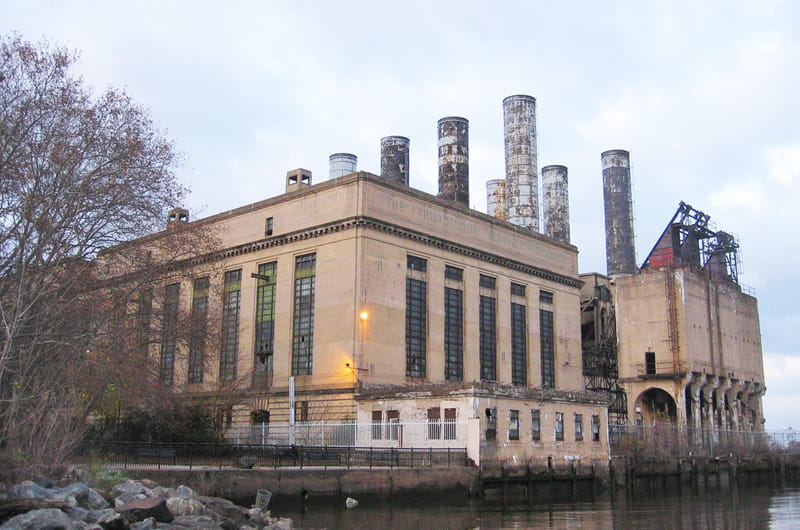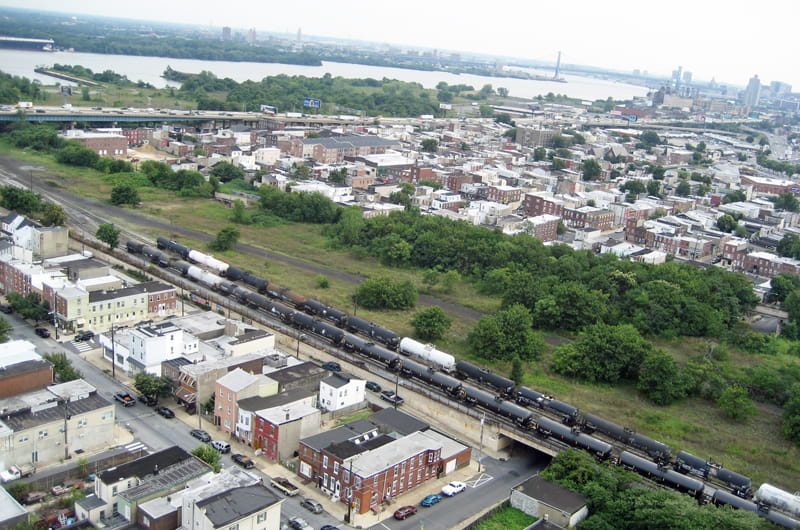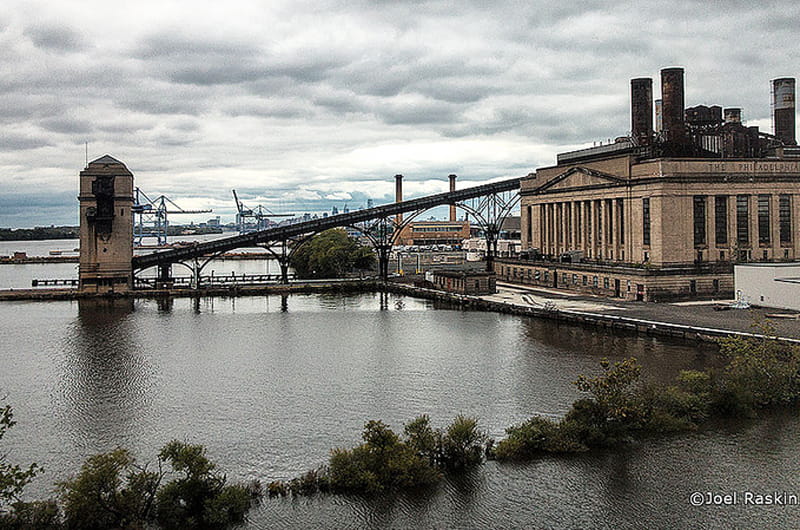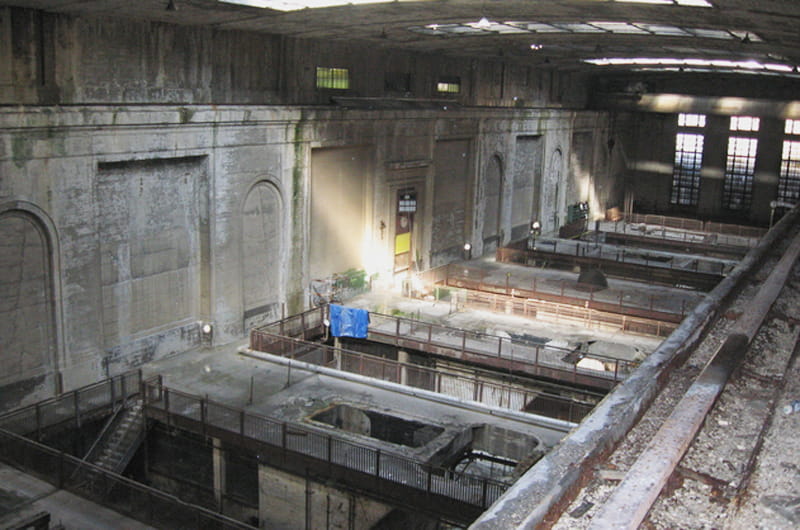Urban Design and Planning Students Reimagine the Delaware River Waterfront

- Own Your Safety in 2026: Simple Steps for a Strong Start
- Drexel Selects New, World-Class Life Sciences Building at 3201 Cuthbert Street for Medical Research Operations
- Turn Happy Places and Memories into a Happy New Year
- Dragons Deliver: Drexel’s Annual Holiday Drives Support Military and Local Families

Once the site of a dozen bustling railroad tracks, today, the Lehigh Viaduct, a wide corridor connecting the Delaware River waterfront with neighborhoods in northern Philadelphia, is mostly overgrown and is off-limits to the public, with only a few sets of rails remaining in use.
Nearby, the Delaware Power Station also sits neglected. The site, which includes a largely vacant 300,000-square foot building – notable as a set for Hollywood productions such as “Transformers 2” and “The Last Airbender” – dominates more than 1,000 feet of waterfront.
Now, a select handful of Drexel University’s Antoinette Westphal College of Media Arts & Design students interested in urban design will have the opportunity to generate fresh ideas and create a vision for the future of the Lehigh Viaduct, Delaware Power Station and surrounding Port Richmond area.

Along with 15 students and two faculty members from Germany’s TU Dortmund University, which researches and teaches the global intersection between man, nature and technology, the students will participate in an intensive urban infrastructure planning and design process to develop concepts for repurposing this post-industrial infrastructure.
“These sites are part of the industrial legacy of Philadelphia, but are now extremely underutilized,” said Harris Steinberg, executive director of Drexel’s Lindy Institute for Urban Innovation and a distinguished teaching professor of architecture and interiors in the Westphal College, who is one of the leading practitioners and teachers of urban planning and civic visioning in the region.
“The Port Richmond rail yard was once the most active rail yard in the world, and is now virtually defunct,” he said. “Likewise, the Power Station, which opened in 1920 as a coal-fired power plant, now operates at only 20 percent of its capacity. Yet these sites have incredible potential."
"We want to know: how can we repurpose these legacy assets from Philadelphia’s industrial past as civic anchors for redeveloping this part of the city?”
The students will bring their broad range of skills and backgrounds to bear in a two-day charrette workshop on Saturday, Feb. 28 and Sunday, March 1, hosted by the Westphal College at the URBN Center (3501 Market Street) and led by Steinberg and his German counterparts.
Both groups have something valuable to contribute to the conversation.
“Whereas the Philadelphia students bring unique insights and a thorough understanding of the local context to the process, the German students provide lessons from best practices in post-industrial regeneration projects in Europe and a fresh viewpoint to the activities,” said Steinberg.
“This is a great opportunity for us to broaden our thinking around urban planning and international relationships.”

On Feb. 28, the students will visit the viaduct, power plant and surrounding area to assess the physical, social and economic aspects of the sites, documenting and analyzing the land uses and existing plans for the sites as well as conducting interviews with experts, residents and other stakeholders. They will then discuss their findings and clarify issues, develop ideas and recommendations and, finally, present their outcomes.
“The goal for the charrette is to provide the community and investors with a starting point and specific action steps for successful community development and quality-of-life enhancement,” said Steinberg.
“The concepts developed are meant as a tool for laying the foundation for the development of a more formal plan.”
The outcomes will be compiled in a comprehensive, reader-friendly document with graphics. It will be available to the public on the websites of Drexel University, the German Marshall Fund and the William Penn Foundation.

Prior to the charrette, a public forum, entitled “Creative Transformations: Lessons from Transatlantic Cities,” featuring international experts and local leaders, will take place on Feb. 26 at 6 p.m. The event is hosted by the German Marshall Fund, with the support of the William Penn Foundation and in collaboration with Drexel. The event will take place at Moore College of Art’s Stewart Auditorium (1916 Race St., Philadelphia). Participation is free and open to the public. Those interested in attending can RSVP here.
The forum aims to expand and deepen the dialogue about how Philadelphia can reposition its abandoned industrial infrastructure as an opportunity to create new, self-sustaining recreational and economic development opportunities. The discussion will include lessons from other national and international cities that have creatively reused industrial sites as new civic and economic assets or improved connectivity between neighborhoods with new types of public spaces. More information on the presentations and expert panelists is available here.
The students from Germany, who arrive in Philadelphia on Feb. 22, also will participate in a workshop on Feb. 26 – 27 considering the same geographic area. They will build on this foundation at the Drexel charrette.
About the German Marshall Fund of the United States
Headquartered in Washington, D.C., the German Marshall Fund is a nonprofit organization that seeks to strengthen transatlantic cooperation on regional, national and global challenges and opportunities. For more information, visit http://www.gmfus.org/about-gmf/.
Drexel News is produced by
University Marketing and Communications.